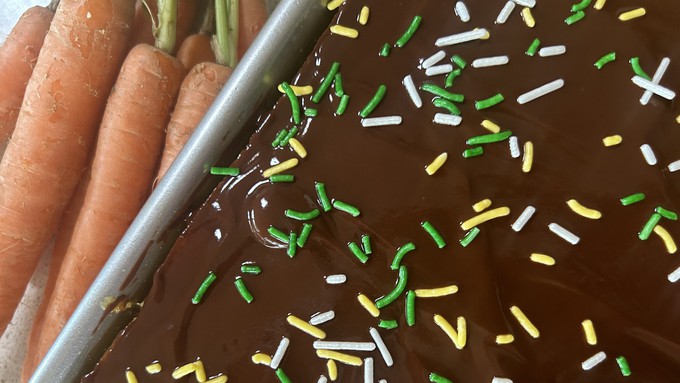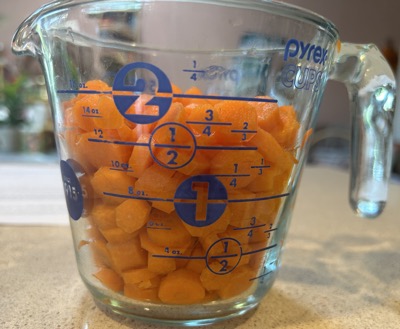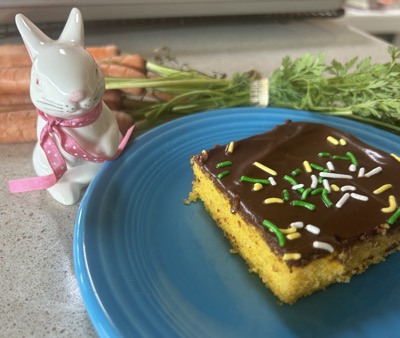
Recipe: Chocolate glaze especially appropriate for a holiday dessert

Carrots and chocolate -- how perfect for Easter or any other spring occasion. Kathy Morrison

Classic American carrot cake, first popular in the 1970s and early '80s, typically is loaded with spices, raisins and chopped nuts, stacked in layers and swathed in thick cream cheese frosting.
It's a fine dessert, but not my favorite, even though the cake at my wedding was "carrot chiffon." (That'll give you a hint at how long my husband and I have been married.)
So when I happened upon this unusual carrot cake recipe, I was immediately intrigued. I had been searching for something different to do with the bunches of sweet little carrots that came in my farm box. They were filling my refrigerator vegetable drawer and needed to be used soon.
The recipe was called "Brazilian carrot cake." I couldn't figure out what made it Brazilian, but I liked the idea of 1) just carrots in the cake and 2) that glossy chocolate glaze on top. The fact that it went together easily, baked in a half-sheet pan like a Texas sheet cake, made it all the more appealing.
"I'll make it for Easter," I decided. "Carrots and chocolate, how appropriate." I wound up using 10 of those little carrots, hence "10-carrot cake," a play on 10-karat.
I can see varying this recipe a bit more. I already reduced the amount of sugar and added vanilla. I could see adding spices -- cardamom, maybe? -- but no nuts or raisins, not in my house. The sprinkles on top are as fancy as it needs to be. And it's very moist, so leftovers will keep for several days.
Chocolate-glazed 10-carrot cake
Serves 16
Ingredients:
2 cups peeled, sliced carrots (10 small or 4-5 large)
3 large eggs
1 cup neutral vegetable oil, such as canola
1/2 teaspoon vanilla extract
1-1/4 to 1-1/2 cups granulated sugar (depending on sweetness desired)
2 cups plus 1 tablespoon unbleached all-purpose flour
1/2 teaspoon salt
1 tablespoon baking powder

Glaze:
1 cup semisweet chocolate chips
6 tablespoons unsalted butter
2 tablespoons honey or agave nectar
Instructions:
Grease a 12-by-18-inch half-sheet pan with oil spray, making sure to get the sides and the corners. (If using a smaller pan, make sure the sides are at least 1-1/2 inches tall, preferably 2 inches, or you'll have batter overflow.) Set it aside.
Preheat the oven to 350 degrees.
The carrots should be thinly sliced, no more than 1/4-inch-thick. Place them in the bowl of a food processor (a blender also will work if you have a strong one) along with about 1/2 cup of the oil, and pulse several times to start breaking them down. Add the rest of the oil, the eggs and the vanilla, and blend until smooth. (You may have to stop and scrape down the sides a few times.)
Add the sugar and blend briefly to combine.
Pour the dry ingredients into the processor or blender and, before turning it on, hand-stir the ingredients with a rubber spatula to get the flour into the wet mixture somewhat. (This helps prevent clumps.) Then blend until the dry ingredients are fully mixed into the batter.
Pour the batter into the prepared pan, distributing it as evenly as possible.

Bake for 22 to 27 minutes, or until a toothpick comes out with just a few moist crumbs.
Cool the cake completely on a wire rack before adding the glaze.
To make the glaze, melt the chocolate chips, butter and honey in a heat-proof bowl over a saucepan of simmering water, stirring occasionally. I typically use a microwave to melt chocolate, but like the double-boiler method for getting this glaze as smooth as possible.
Pour the warm glaze over the cooled cake, spreading it evenly with an offset spatula. If desired, add sprinkles or other decor soon, before the glaze sets.
Once the glaze is set, cut and serve.
Comments
0 comments have been posted.Sacramento Digs Gardening to your inbox.
Food in My Back Yard Series
April 1: Don't be fooled by these garden myths
March 25: Fertilizer tips: How to 'feed' your vegetables for healthy growth
March 18: Time to give vegetable seedlings some more space
March 11: Ways to win the fight against weeds
March 4: Potatoes from the garden
Feb. 25: Plant a fruit tree now -- for later
Feb. 18: How to squeeze more food into less space
Feb. 11: When to plant? Consider staggering your transplants
Feb. 4: Starting in seed starting
Sites We Like
Garden Checklist for week of March 30
Your garden doesn’t mind April showers. Get busy now to enjoy those future flowers.
* Get ready to swing into action in the vegetable garden. As nights warm up over 50 degrees, start setting out tomato, pepper and eggplant transplants.
* From seed, plant beans, beets, cantaloupes, carrots, corn, cucumbers, melons, pumpkins, radishes and squash. (Soak beet seeds overnight in water for better germination,)
* Plant onion sets.
* In the flower garden, plant seeds for asters, cosmos, celosia, marigolds, salvia, sunflowers and zinnias.
* Transplant petunias, zinnias, geraniums and other summer bloomers.
* Plant perennials and dahlia tubers for summer bloom.
* Transplant lettuce and cabbage seedlings.
* April is the last chance to plant citrus trees such as dwarf orange, lemon and kumquat. These trees also look good in landscaping and provide fresh fruit in winter.
* Smell orange blossoms? Feed citrus trees with a low dose of balanced fertilizer (such as 10-10-10) during bloom to help set fruit. Keep an eye out for ants.
* Apply slow-release fertilizer to the lawn.